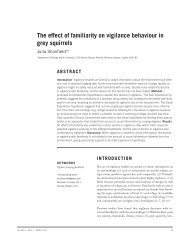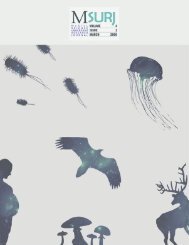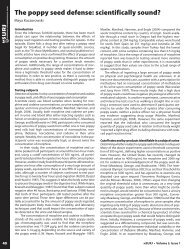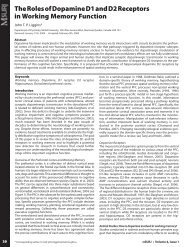the entire issue - McGill Science Undergraduate Research Journal ...
the entire issue - McGill Science Undergraduate Research Journal ...
the entire issue - McGill Science Undergraduate Research Journal ...
You also want an ePaper? Increase the reach of your titles
YUMPU automatically turns print PDFs into web optimized ePapers that Google loves.
Autosomal Recessive Spastic Ataxia of Charlevoix-Saguenay (ARSACS): a once obscure neurodegenerative disease with increasing significance for neurological research<br />
two leucine zippers (a leucine-rich motif known to mediate protein<br />
dimerization (47)), three coiled coils and one hydrophilic domain in<br />
<strong>the</strong> carboxyl-terminal half of <strong>the</strong> peptide (7). To date, bioinformatics<br />
analyses have identified five distinct peptide domains in sacsin and<br />
<strong>the</strong>ir respective functions have been characterized to varying extents<br />
(See Fig. 1 for <strong>the</strong> location of <strong>the</strong> domains and selected ARSACS-causing<br />
mutations in sacsin) (48).<br />
The N-terminal end of sacsin contains an ubiquitin-like domain (UbL)<br />
that was first reported by Parfitt et al. in 2009. Co-immunoprecipitation<br />
experiments have demonstrated <strong>the</strong> ability of N-terminal region<br />
of sacsin (up to and including <strong>the</strong> UbL domain) to directly interact<br />
with <strong>the</strong> 19S cap of <strong>the</strong> 26S proteasome, <strong>the</strong> primary protein-degradation<br />
machinery in eukaryotic cells (46). Never<strong>the</strong>less, this does<br />
not exclude <strong>the</strong> possibility that <strong>the</strong> observed interaction between<br />
<strong>the</strong> N-terminal region of sacsin and <strong>the</strong> proteasome could be due<br />
polyubiquitination-mediated targeting of sacsin to <strong>the</strong> proteasome<br />
instead of direct interaction between <strong>the</strong> sacsin-UbL domain and <strong>the</strong><br />
proteaosome (46).<br />
Towards <strong>the</strong> C-terminal direction, <strong>the</strong> next discernable structural<br />
entity consists of three SRRs (sacsin repeat regions), each of which is<br />
a supra-domain (complex of multiple independent peptide domains<br />
exerting synergistic functions) consisting of an N-terminal domain<br />
homologous to <strong>the</strong> Hsp90 (a chaperone)-ATPase domain and a hydrophobic<br />
C-terminal domain of unknown function (49). The sacsin-SRRs<br />
were first described by Engert et al. upon <strong>the</strong>ir identification of <strong>the</strong><br />
SACS gene in 2000 and <strong>the</strong> ATPase activity of <strong>the</strong> N-terminal domain<br />
of <strong>the</strong> first SRR was verified by Anderson et al. to be similar to that of<br />
yeast Hsp90 (with turnover rates of 2.5/min and 1/min, respectively)<br />
(7, 49). In addition, ARSACS-causing missense mutations D168Y and<br />
R2703C in <strong>the</strong> first and third SRRs were both shown to abolish <strong>the</strong><br />
ATPase activity of <strong>the</strong> <strong>entire</strong> protein, <strong>the</strong>reby confirming <strong>the</strong> nonredundancy<br />
in <strong>the</strong> functions of <strong>the</strong> three SRRs in sacsin (15, 18). Bis-<br />
1-anilinoaphthalene 8-sulfonate (a molecule that becomes highly<br />
fluorescent when interacting with exposed hydrophobic surface of<br />
proteins) fluorescence measurement experiment revealed substantially<br />
increased surface hydrophobicity of <strong>the</strong> mutant SRR compared<br />
with <strong>the</strong> wild-type, indicating disruption in <strong>the</strong> normal folding of <strong>the</strong><br />
supra-domain. However, since <strong>the</strong> study also demonstrated that <strong>the</strong><br />
mutant protein remained soluble in <strong>the</strong> cell, <strong>the</strong> mutant SRR is most<br />
likely still able to fold to <strong>the</strong> extent of avoiding aggregation but with<br />
structural alterations significant enough to abrogate its ATPase activity<br />
(49).<br />
The domain C-terminal to <strong>the</strong> third SRR was identified as XPCB domain<br />
by Kamionka et al. in 2004 (50). The sacsin XPCB-domain was<br />
found to exhibit 35% sequence identity with <strong>the</strong> hHR23 XPCB domain<br />
(50). hHR23 had been known to bind to and stabilize XPC, initiator of<br />
<strong>the</strong> global genome repair pathway. The hHR23/XPC complex is implicated<br />
in group C xeroderma pigmentosum (XP-C), a rare nucleotide<br />
excision repair deficiency disorder characterized by markedly increased<br />
photosensitivity and propensity for developing UV-induced<br />
skin cancer (50).<br />
Interestingly, <strong>the</strong> hHR23 protein also contains an UbL domain, which<br />
has been shown to interact with <strong>the</strong> 19S regulatory subunit of proteasome<br />
in vivo (51). The 19S subunit of <strong>the</strong> proteasome has been found<br />
to exhibit independent chaperone-like activity, which was suggested<br />
to help maintain <strong>the</strong> proper conformation of <strong>the</strong> highly hydrophobic<br />
XPC molecule on XPCB (49). Since sacsin also contains an UbL<br />
domain, <strong>the</strong> sacsin-XPCB domain most likely function in a similar<br />
fashion as hHR23 and delivers <strong>the</strong> binding partner of sacsin to <strong>the</strong><br />
proteasome or chaperones. However, <strong>the</strong> binding partner as well as<br />
<strong>the</strong> cellular activity of <strong>the</strong> sacsin-XPCB is yet to be identified.<br />
The penultimate domain at <strong>the</strong> C-terminus of sacsin is <strong>the</strong> J-domain,<br />
first reported by Parfitt et al. in 2009 (46). J-domains are integral<br />
components of <strong>the</strong> DnaJ/Hsp40-class chaperones and mediate <strong>the</strong><br />
interaction between Hsp40 and Hsp70 to enhance Hsp70’s ATPase<br />
and substrate-binding activity (52). The Hsp40-Hsp70 complex constitutes<br />
<strong>the</strong> primary cellular machinery in assisting protein folding<br />
and quality control (52). Sequence alignment between sacsin- and<br />
Hsp40/DnaK-J-domains revealed a 60% similarity over 30 residues<br />
and <strong>the</strong> ability of <strong>the</strong> sacsin J-domain to recruit and stimulate Hsp70<br />
and stimulate its chaperone activity was verified by in vivo complementation<br />
assays in bacteria (46). To date, <strong>the</strong> only identified AR-<br />
SACS-causing mutation in <strong>the</strong> sacsin J-domain is <strong>the</strong> compound heterozygous<br />
mutation K1715X/R4331Q, with <strong>the</strong> arginine occupying a<br />
position known to be critical for <strong>the</strong> function of J-domains in most<br />
proteins (15). Note that since <strong>the</strong> R4331Q mutation alone did affect<br />
<strong>the</strong> ability of <strong>the</strong> sacsin J-domain to rescue <strong>the</strong> function of mutant<br />
bacterial DnaJ (Hsp40 class chaperone) with nonfunctional J-domain,<br />
both mutations most likely need to be present to exert a perceptible<br />
effect on <strong>the</strong> function of sacsin J-domain (46). The fact that K1715X<br />
Fig. 1<br />
A schematic diagram of sacsin showing <strong>the</strong> known structural<br />
domains and selected ARSACS-causing mutations. Note that <strong>the</strong><br />
numbers in 6594delT and 5254C-T represent <strong>the</strong> position of <strong>the</strong><br />
mutated nucleotide whereas <strong>the</strong> numbers in <strong>the</strong> rest of <strong>the</strong> mutations<br />
presented in <strong>the</strong> diagram indicate <strong>the</strong> position of <strong>the</strong> mutated<br />
amino acid.<br />
Volume 8 - Issue 1 - March 2013 71









